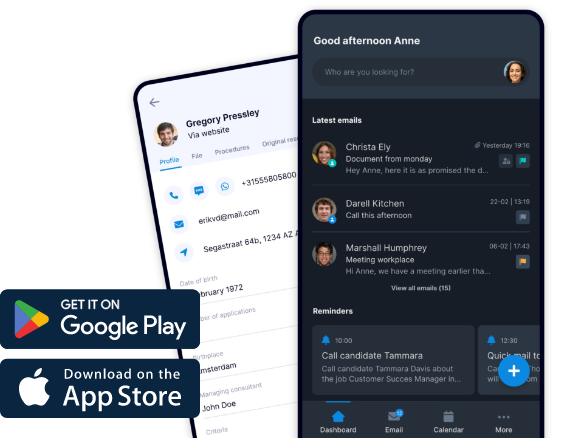Missed language opportunities in inclusive writing – data can help you!

Like many other organizations, have you paid a lot of attention to diversity and inclusivity within the organization in recent years? Then you also know how difficult it is to achieve the goals you set for this. An often underexposed subject has to do with the content, the text, of all kinds of expressions. You can think of vacancy texts, but also internal newsletters and other media through which you want to reach both your own employees and future employees. The aim is to reach as many people as possible. And to above all, not exclude groups of people. Inclusive writing is the key word here.
But what exactly is inclusive writing, and where does it go wrong? And how can data help you with inclusive writing?
What is inclusive writing?
When we talk about diversity and inclusivity, vacancies play an urgent role. Especially if your goal is to hire a greater diversity of people. You can look for diversity in age, gender and cultural background, but for instance also in educational background and personality. A vacancy is written inclusively if it appeals to all these people at the same time, and if no one feels left out when they read the text.
You can do inclusive writing by taking into account the following general points:
- People-oriented writing, also known as gender neutral writing. You do this by using he/she or the plural.
- Address the reader with you or you.
- Make sure your content doesn't discriminate by age. You do this of course by not mentioning ages in your text.
- Avoid stereotyping in words and/or associations. You probably use them unconsciously more often than you think.
- Think of “caring” for women and “powerful” for men.
- Digital accessibility. Applying the WCAG's rules (more on this later) ensures that the text is accessible to everyone. So also for people with disabilities.
The 3 biggest language missed opportunities
Nevertheless, inclusive writing still regularly goes wrong. And that often happens unconsciously. When writing vacancy texts, you run the risk of only addressing a small group of potential candidates. This makes the chance of finding the perfect, diverse, candidate even smaller.
What goes wrong then if we want to write inclusively?
1. The language level: make it easy and pleasant to read for a large group
The goal of inclusive writing is that everyone can find and understand your vacancy. Various studies by Textmetrics within 300 Dutch companies have shown that many vacancy texts are written too difficult. Of course, highly educated people can understand more complex texts. But that doesn't mean they want to read it. If you pay attention to writing in understandable language, it will take the reader less time and energy to read the text. In doing so, they are more likely to become enthusiastic and motivated by a text that is not too complex.
What makes a text easy and pleasant to read? For that keep the following points in mind:
- Do not use difficult/specialist words, but choose words that everyone knows.
- Write concise, lively sentences that are easy to read.
Do not forget to give the vacancy text a clear title and subheadings. - Use bullet points and keep your paragraphs short.
- Choose a legible font and enough white spaces.
2. Bias: don't discriminate (unknowingly) on age and gender
Inclusive writing is done to address different types of people. You should not make any distinction based on age or gender. Unfortunately, this still happens (consciously and unconsciously) in many vacancy texts. For example, it may state that organizations are looking for students. Or that they are looking for candidates with a maximum of 8 years of work experience. By avoiding these kinds of sentences you can prevent age discrimination. A more sophisticated form of ageism in job openings can for example be describing the team as young and energetic.
There is something else going on when it comes to gender bias. Unconsciously, many texts have a more masculine tone of voice, which makes women feel less addressed when they read these texts. In many vacancies we also see words that refer to characteristics that are known as 'masculine'. See below some examples of masculine and feminine words.
Male | Female |
Autonomously | Involved |
Analytical | Communicative |
Decisive | Customer-friendly |
Result-oriented | Honest |
Driven | Sensitive |
Firmly | Committed |
Below you will find an example of a male-formulated job requirement
You are result oriented
Do you want to make this sentence feminine or gender neutral? Then choose the focus on behaviour:
You are able to achieve results
Check your vacancy texts for the amount of male (or female) characteristics you name in the profile and strive for a good mix of both.
3. The accessibility
You publish most vacancies online. No less than 25% of all internet users have a functional limitation. Then you have to think of people who are, for example, hard of hearing, blind or color blind. So you have to take digital accessibility into account. You don't just want to appeal to more people, but above all you don't want to exclude anyone.
It revolves around 4 principles. Include these in the texts you write for online use. The text must:
- Be observable: people should be able to experience and use the website with the senses they have. Think of text alternatives for non-text content such as a video or image.
- Be operable: people should be able to find and use the content on the website. For example, a page with content must also only be navigable with a keyboard and without a mouse.
- Be understandable: people and software must be able to understand the content. Think of making the content readable and clear and of the language level.
- Be robust: this is a bit technical, but the point is that the content must be reliable to interpret.
The above principles seem obvious, but various analyzes by Textmetrics show the opposite. The aforementioned study among 300 Dutch companies also looked at digital accessibility. The vast majority of companies have multiple accessibility issues.
Inclusive writing thanks to augmented writing
The what and why of inclusive writing is clear. But the writing itself is trickier than you might think. As we saw above, there is a lot to consider. A condition is that you can place yourself in various target groups while writing.
Fortunately, there are handy tools that can help you make inclusive writing a lot easier. Then we are talking about data-driven platforms (eg Textmetrics). These can help to prevent exclusion through language use. You can see such a platform as a writing coach, who helps you achieve the D&I objectives.
In addition, many augmented writing platforms also give you suggestions for
- Tone of voice
- SEO Optimization
- Avoiding words that are too difficult for the target audience
Would you like to know more about how a platform like Textmetrics can help you? Read more about Textmetrics' Smart Writing Assistant here.
